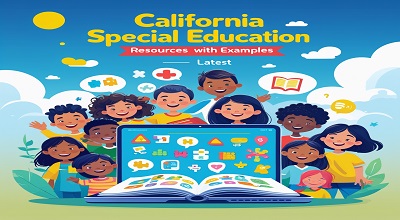California Special Education Resources
California Special Education Resources: Special education in California is designed to provide students with disabilities access to a free and appropriate public education (FAPE) tailored to their unique needs. Governed by federal and state laws, California ensures that eligible students receive specialized instruction, support services, and accommodations.
With over 800,000 students receiving special education services in California, the state offers a variety of programs, from early intervention to transition services for young adults. This article explores the latest resources, programs, and strategies available to support students, parents, and educators.
Legal Framework for Special Education in California
California adheres to federal laws, including:
- Individuals with Disabilities Education Act (IDEA) – Ensures FAPE for students with disabilities.
- Section 504 of the Rehabilitation Act – Prohibits discrimination based on disability.
- Americans with Disabilities Act (ADA) – Guarantees equal opportunities in public spaces.
California-Specific Laws:
- California Education Code (CEC) – Outlines state-specific special education policies.
- AB 602 Funding Model – Allocates funds based on total student population rather than specific disabilities.
Example: A school district must provide speech therapy under IDEA if a student’s IEP includes it.
California Special Education Programs and Services
California offers various programs, including:
A. Special Day Classes (SDC)
- Small-group instruction for students with moderate to severe disabilities.
- Example: A student with autism may attend an SDC for structured learning.
B. Resource Specialist Program (RSP)
- Part-time support for students in general education classrooms.
- Example: A student with dyslexia receives reading intervention from an RSP teacher.
C. Non-Public Schools (NPS) and Agencies
- For students requiring highly specialized education not available in public schools.
- Example: A student with severe emotional disturbance may attend an NPS.
D. Related Services
- Speech therapy, occupational therapy, counseling, and transportation.
- Example: A student with cerebral palsy receives physical therapy at school.
Individualized Education Program (IEP) in California
An IEP is a legally binding document outlining a student’s special education services.
IEP Team Members:
- Parents
- General and special education teachers
- School psychologist
- Related service providers
Example of IEP Goals:
- Academic: “By the end of the year, the student will read at a 3rd-grade level with 80% accuracy.”
- Behavioral: “The student will use self-regulation strategies in 4 out of 5 instances.”
Early Intervention Services (0-3 Years)
California’s Early Start Program provides services for infants and toddlers with developmental delays.
Services Include:
- Speech and language therapy
- Physical therapy
- Family training
Example: A 2-year-old with delayed speech receives weekly therapy through a regional center.
Special Education Resources for Parents and Guardians
A. Parent Training and Information Centers (PTI)
- Support for Families (San Francisco)
- Matrix Parent Network (North Bay)
B. Advocacy Organizations
- Disability Rights California – Legal support for families.
- The ARC of California – Advocacy for intellectual and developmental disabilities.
Example: A parent uses Disability Rights CA to file a complaint against a school denying services.
Technology and Assistive Tools for Special Education
A. Communication Devices
- Augmentative and Alternative Communication (AAC) tools like Proloquo2Go.
B. Learning Software
- Kurzweil 3000 – Text-to-speech for dyslexic students.
Example: A non-verbal student uses an iPad with AAC to communicate in class.
Inclusive Education Strategies in California
- Universal Design for Learning (UDL) – Multiple ways to engage students.
- Co-Teaching Models – General and special education teachers collaborate.
Example: A student with ADHD uses fidget tools and movement breaks in an inclusive classroom.
Professional Development for Special Education Teachers
- California Department of Education (CDE) Workshops
- Autism Spectrum Disorder (ASD) Certification Programs
Example: A teacher completes a CDE training on behavioral interventions.
Funding and Grants for Special Education
- AB 602 Funds – Allocated per student.
- Federal IDEA Grants – Support for low-incidence disabilities.
Example: A school district uses IDEA funds to hire additional speech therapists.
Challenges and Future Trends in California Special Education
- Teacher Shortages
- Increasing Autism Diagnoses
- Teletherapy Expansion
Example: Post-pandemic, schools adopt virtual IEP meetings for flexibility.
Conclusion
California provides extensive special education resources, from IEPs to assistive technology. Parents, educators, and policymakers must collaborate to ensure equitable access for all students.
FAQs
1. What is the age range for special education services in California?
Services are available from birth to 22 years, covering early intervention, K-12, and transition programs.
2. How do I request an IEP evaluation in California?
Submit a written request to your school district, which must respond within 15 days.
3. Can students with disabilities attend charter schools in California?
Yes, charter schools must comply with IDEA and provide special education services.
4. What if I disagree with my child’s IEP?
You can request mediation, file a due process complaint, or seek help from Disability Rights California.
5. Are there scholarships for students with disabilities in California?
Yes, programs like the Jon Peterson Special Needs Scholarship (if applicable) and ABLE Savings Accounts help with education costs.
Free Download Link: Xray Clothes Scanner Simulator APK
